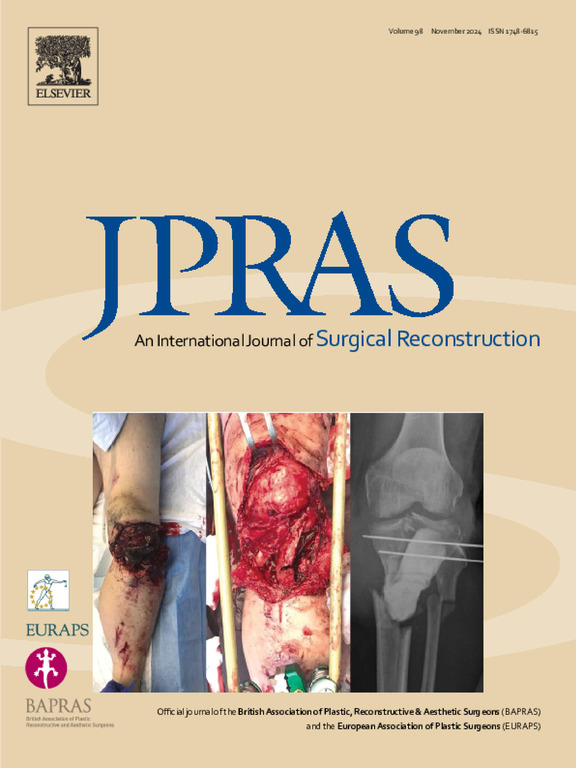Measuring the effects of facial regional changes following excessive aesthetic treatments—A survey and eye-tracking-based investigation
IF 2.4
3区 医学
Q2 SURGERY
Journal of Plastic Reconstructive and Aesthetic Surgery
Pub Date : 2025-04-20
DOI:10.1016/j.bjps.2025.04.027
引用次数: 0
Abstract
Background
The increasing popularity of minimally invasive soft tissue filler injections has been accompanied by a significant rise in filler reversal procedures, highlighting the concerns regarding adverse effects, including the facial overfilled syndrome (FOS). This trend suggests a growing need to understand individual facial regions contributing to FOS and their influence on patient perception.
Objective
To investigate the influence of exaggerated volumization of facial regions on the perceptions of attractiveness and gender traits using eye-tracking and survey methods to better understand FOS.
Methods
A total of 50 volunteers (30 women and 20 men) rated frontal images of different modified facial regions (i.e., eyes, cheeks, and lips) and the combination thereof on 5-point Likert scales for attractiveness, unattractiveness, masculinity, and femininity. Their gaze patterns and eye movements were analyzed using eye-tracking technology.
Results
Elevating the lateral canthal angle sharply reduces the attractiveness in male and female faces. Accentuating the zygomatic arch generally decreases attractiveness and masculinity, particularly in men, while slightly increasing femininity. Lip volumization in women marginally increases attractiveness without significantly altering femininity. In combined modifications, the decrease in attractiveness is predominantly driven by the eye modification aspect, leading to the most substantial decline in the perceived attractiveness and gender-specific traits.
Conclusion
Certain facial modifications such as lip enhancement may increase attractiveness, while cheek enhancements may increase femininity. However, most alterations, particularly those involving the eyes or combinations of treatments, generally decrease attractiveness and impact the perceptions of femininity and masculinity. This underscores the need for balanced aesthetic treatments to prevent overcorrection.
测量过度美容治疗后面部区域变化的影响——一项调查和基于眼动追踪的调查
背景:微创软组织填充物注射的日益普及伴随着填充物逆转手术的显著增加,突出了对不良反应的关注,包括面部过度填充综合征(FOS)。这一趋势表明,越来越需要了解个体面部区域对FOS的影响及其对患者感知的影响。目的采用眼动追踪和问卷调查的方法,探讨面部区域体积夸大对吸引力感知和性别特征的影响,以更好地理解FOS。方法共有50名志愿者(30名女性和20名男性)对不同修改过的面部区域(即眼睛、脸颊和嘴唇)的正面图像及其组合进行评分,评分标准为吸引力、不吸引力、男性气质和女性气质5分李克特量表。研究人员利用眼球追踪技术分析了他们的凝视模式和眼球运动。结果提高侧眦角度会显著降低男性和女性的吸引力。突出颧骨弓通常会降低吸引力和男子气概,尤其是男性,而略微增加女性气质。女性丰满的嘴唇会略微增加吸引力,但不会显著改变女性气质。在综合修饰中,吸引力的下降主要是由眼睛修饰方面驱动的,导致感知吸引力和性别特征的最大幅度下降。结论:某些面部修饰,如丰唇可能会增加吸引力,而丰颊可能会增加女性气质。然而,大多数改变,特别是那些涉及眼睛或治疗组合的改变,通常会降低吸引力,影响对女性和男性气质的看法。这强调了平衡美学治疗的必要性,以防止矫治过度。
本文章由计算机程序翻译,如有差异,请以英文原文为准。
求助全文
约1分钟内获得全文
求助全文
来源期刊
CiteScore
3.10
自引率
11.10%
发文量
578
审稿时长
3.5 months
期刊介绍:
JPRAS An International Journal of Surgical Reconstruction is one of the world''s leading international journals, covering all the reconstructive and aesthetic aspects of plastic surgery.
The journal presents the latest surgical procedures with audit and outcome studies of new and established techniques in plastic surgery including: cleft lip and palate and other heads and neck surgery, hand surgery, lower limb trauma, burns, skin cancer, breast surgery and aesthetic surgery.

 求助内容:
求助内容: 应助结果提醒方式:
应助结果提醒方式:


